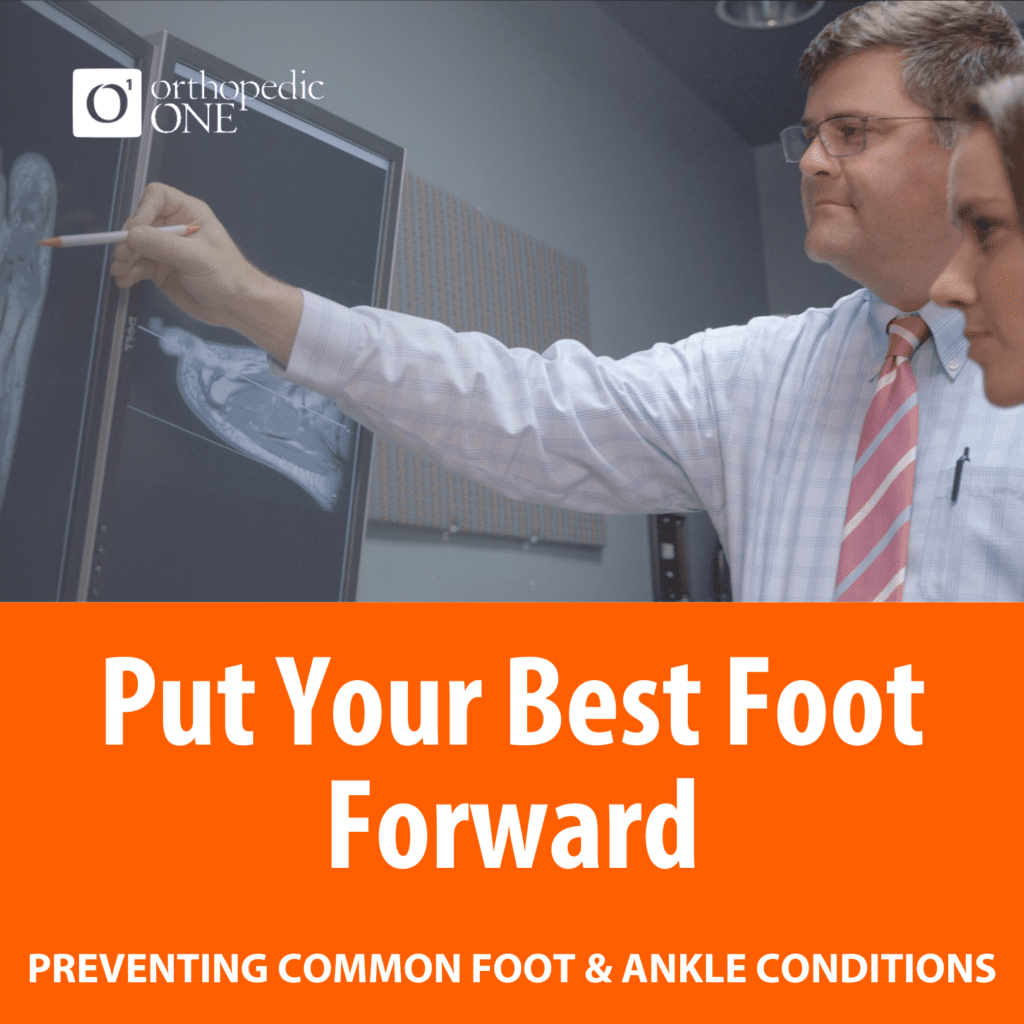Put Your Best Foot Forward: Preventing Common Foot & Ankle Conditions
Your feet and ankles support you every day, providing a solid foundation and carrying your weight with each step you take. Yet, many people neglect the early signs of foot and ankle conditions, allowing minor issues to escalate into major problems.

At Orthopedic ONE, we’re here to help you understand the importance of your foot and ankle health and why early intervention is key to maintaining a pain-free, active lifestyle. In fact, we have more fellowship-trained orthopedic foot and ankle surgeons than any other practice in central Ohio.
What’s the difference between a fellowship-trained foot & ankle surgeon and a podiatrist? Find out here.
Common Foot and Ankle Conditions
Foot Conditions
Hammer Toe
Hammer toe is a deformity where the toe bends downward instead of pointing forward. It often results from wearing ill-fitting shoes or an imbalance in the toe muscles. Symptoms can include pain, corns, and difficulty walking. Without prompt treatment, hammer toe can become rigid and lead to more severe discomfort, potentially requiring surgical intervention. Learn more.
Plantar Fasciitis
Plantar fasciitis is characterized by inflammation of the plantar fascia, the ligament connecting the heel to the toes. It causes sharp pain in the heel, especially in the morning or after prolonged periods of rest. Early signs include heel pain after exercise or long stretches of standing. While ignoring these symptoms may lead to chronic pain and a prolonged recovery period, plantar fasciitis can usually be treated with conservative care. Learn more.
Bunions
A bunion is a bony bump that forms on the joint at the base of the big toe. It can cause severe pain and swelling, making it difficult to wear shoes and walk comfortably. Early signs include a visible bump on the side of the foot and discomfort around the big toe joint. Addressing bunions early with orthotic devices or appropriate footwear can prevent the need for surgical intervention later on. Learn more.
Ankle Conditions
Chronic Ankle Instability
Sometimes the ankle can feel wobbly, unstable and like it “gives way”—even while standing still. When this happens repeatedly, the condition is called ankle instability.
Ankle Sprains
Ankle sprains occur when the ligaments that support the ankle stretch beyond their limits, or even tear. This common injury can range from mild to severe, with symptoms including swelling, pain, and instability. Early treatment with rest, ice, compression, and elevation (RICE) can prevent further damage and ensure proper healing. Learn more.
Achilles Tendon Injuries
The Achilles tendon connects the calf muscles to the heel bone and is prone to injuries such as tears or ruptures. These injuries often result from sudden increases in activity intensity or inadequate warm-up. Early signs include pain and swelling near the heel. Prompt treatment with rest and physical therapy with one of our qualified specialists can help prevent severe damage. Learn more.
Signs and Symptoms to Watch Out For
While each foot and ankle condition has specific symptoms, some general warning signs may be:
- Persistent pain or tenderness
- Swelling or inflammation
- Difficulty walking or bearing weight
- Ankle instability (wobbly or unstable feeling)
- Visible changes in foot/ankle shape
- Stiffness or limited range of motion
- Numbness or tingling
Ignoring these signs can lead to complications, which is why it’s essential to seek professional advice as soon as possible if you notice any of these symptoms. The sooner you receive professional treatment, the less likely it is that you’ll need surgical intervention later on.
Orthopedic ONE provides non-invasive and minimally invasive treatment options like orthotics and injections that can help to resolve complications before they develop into more serious injuries. Our doctors can also help you to determine and implement lifestyle changes, or connect you with a skilled physical therapist depending on the severity of your condition. No matter your needs, Orthopedic ONE has the tools and expertise to keep you healthy from head to toe.
The Importance of Prevention & Prompt Treatment
If you’re hoping to prevent foot and ankle conditions from developing or worsening down the line, consider:
- Wearing properly fitted shoes with adequate support
- Regularly stretching and strengthening foot and ankle muscles
- Gradually increasing the intensity of physical activities
- Taking breaks and avoiding overuse
- Maintaining a healthy weight to reduce pressure on feet and ankles
Prompt treatment is crucial to prevent minor issues from becoming significant ones. At Orthopedic ONE, we recommend seeking medical attention if you experience any persistent discomfort or other symptoms. Early diagnosis and treatment can lead to more effective and less invasive interventions, ensuring quicker recovery timelines and a return to normal activities.
Orthopedic ONE is committed to providing comprehensive care to help you maintain healthy, pain-free feet and ankles. If you’re experiencing any symptoms or have concerns about your foot and ankle health, connect with us to schedule a consultation. Prompt treatment is the key to preventing more serious problems and ensuring a swift recovery. By understanding and addressing these common conditions early, you can keep your foundation strong—and Orthopedic ONE is here to support you, every step of the way.
The information provided in this article is for educational purposes only and is not intended as professional medical advice. Please consult your healthcare provider for professional advice, diagnoses, or treatment.
Sources:
5 Reasons to See a Foot/Ankle Surgeon (Orthopedic ONE)
Claw and Hammer Toe (Orthopedic ONE)
Plantar Fasciitis (Orthopedic ONE)
Chronic Ankle Instability (Orthopedic ONE)
Sprained Ankle (Orthopedic ONE)